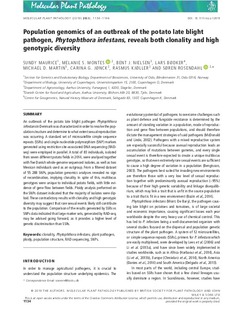| dc.contributor.author | Maurice, Sundy Ursula Mary Jane | |
| dc.contributor.author | Montes, Melanie | |
| dc.contributor.author | Nielsen, Bent J. | |
| dc.contributor.author | Bødker, Lars | |
| dc.contributor.author | Martin, Michael David | |
| dc.contributor.author | Jønck, Carina | |
| dc.contributor.author | Kjøller, Rasmus | |
| dc.contributor.author | Rosendahl, Søren | |
| dc.date.accessioned | 2020-01-03T07:20:13Z | |
| dc.date.available | 2020-01-03T07:20:13Z | |
| dc.date.created | 2019-09-11T09:00:17Z | |
| dc.date.issued | 2019 | |
| dc.identifier.citation | Molecular plant pathology. 2019, 20 (8), 1134-1146. | nb_NO |
| dc.identifier.issn | 1464-6722 | |
| dc.identifier.uri | http://hdl.handle.net/11250/2634679 | |
| dc.description.abstract | An outbreak of the potato late blight pathogen Phytophthora infestans in Denmark was characterized in order to resolve the population structure and determine to what extent sexual reproduction was occurring. A standard set of microsatellite simple sequence repeats (SSRs) and single nucleotide polymorphism (SNP) markers generated using restriction site‐associated DNA sequencing (RAD‐seq) were employed in parallel. A total of 83 individuals, isolated from seven different potato fields in 2014, were analysed together with five Danish whole‐genome sequenced isolates, as well as two Mexican individuals used as an outgroup. From a filtered dataset of 55 288 SNPs, population genomics analyses revealed no sign of recombination, implying clonality. In spite of this, multilocus genotypes were unique to individual potato fields, with little evidence of gene flow between fields. Ploidy analysis performed on the SNPs dataset indicated that the majority of isolates were diploid. These contradictory results with clonality and high genotypic diversity may suggest that rare sexual events likely still contribute to the population. Comparison of the results generated by SSRs vs SNPs data indicated that large marker sets, generated by RAD‐seq, may be advised going forward, as it provides a higher level of genetic discrimination than SSRs. | nb_NO |
| dc.language.iso | eng | nb_NO |
| dc.publisher | British Society for Plant Pathology and John Wiley & Sons Ltd | nb_NO |
| dc.rights | Navngivelse 4.0 Internasjonal | * |
| dc.rights.uri | http://creativecommons.org/licenses/by/4.0/deed.no | * |
| dc.title | Population genomics of an outbreak of the potato late blight pathogen, Phytophthora infestans, reveals both clonality and high genotypic diversity | nb_NO |
| dc.type | Journal article | nb_NO |
| dc.type | Peer reviewed | nb_NO |
| dc.description.version | publishedVersion | nb_NO |
| dc.source.pagenumber | 1134-1146 | nb_NO |
| dc.source.volume | 20 | nb_NO |
| dc.source.journal | Molecular plant pathology | nb_NO |
| dc.source.issue | 8 | nb_NO |
| dc.identifier.doi | 10.1111/mpp.12819 | |
| dc.identifier.cristin | 1723477 | |
| dc.description.localcode | This is an open access article under the terms of the Creative Commons Attribution License, which permits use, distribution and reproduction in any medium, provided the original work is properly cited. | nb_NO |
| cristin.unitcode | 194,31,10,0 | |
| cristin.unitname | Institutt for naturhistorie | |
| cristin.ispublished | true | |
| cristin.fulltext | original | |
| cristin.qualitycode | 1 | |

